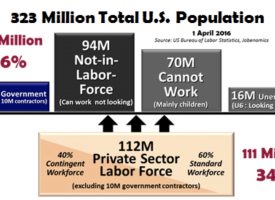Yesterday it was gold and silver down, mining stocks up, today gold and silver up, mining stocks down, which is all part of the crazy world of centrally planned markets…until they break. In the meantime, here are the surprising things people have been doing during the lockdown as well as a look at real estate.
Americans Smoked More, Drank More
November 4 (King World News) – Gerald Celente: U.S. sales of tobacco products edged up 0.4 percent last year, the first annual increase in two decades, according to a report by the U.S. Federal Trade Commission.
Americans stuck at home with little to do and few opportunities to travel or socialize smoked more, CEO Billy Gifford of cigarette-maker Altria Group, formerly Philip Morris, said to The Wall Street Journal.
Tobacco companies took advantage of the opportunity, upping their investments in marketing from $7.62 billion in 2019 to $7.84 billion in 2020.
Alcohol sales also rose last year, especially among costlier brands and varieties, the WSJ reported.
TRENDPOST
While the COVID virus sickened millions, the COVID War took its own toll on people’s health.
Locked in their homes, people craved comfort and relief and indulged in familiar distractions—cigarettes, beer, liquor, television, and junk food.
Pepsi sales shot up during the shutdown and the company couldn’t keep up with demand for its “Cheetos Mac and Cheese” food-like product (“PepsiCo is in the Chips,” 6 Oct 2020); McDonald’s store sales are up more than 13 percent since March 2020.
The longer politicians insist on measures that keep people away from their normal pursuits, the greater the non-COVID toll on public health.
And, as continually report in The Trends Journal, according to the Centers for Disease Control and Prevention, nearly 80 percent of the people that have been hospitalized with COVID-19 are either obese or overweight. Thus, with weights rising and physical conditions declining, there are more health crises on the near horizon…
To learn which company billionaire Eric Sprott bought a
$10 million stake in click here or on the image below

Real Estate
Investors snapped up commercial properties at a record pace during the third quarter, The Wall Street Journal reported, especially apartment buildings, facilities equipped as life-science labs, and warehouses that can or do serve as distribution centers for e-commerce.
Sales totaled a record $193 billion, 19 percent more than in the same period in 2019, according to Real Capital Analytics (RCA).
The third-quarter performance brought year-to-date sales to $462.1 billion, 10 percent above the same stretch in 2019.
Foreign investors also are becoming more active in U.S. commercial real estate, with South Korea’s Meritz Alternative Investment Management buying 49-percent shares of a Manhattan building and another in Washington, DC.
Sales were strong enough during 2021’s first nine months that they offset declining sales of office buildings and shopping malls, RCA noted.
Demand drove prices to never-before-seen highs.
Green Street’s index of properties owned by real estate trusts has risen 26 percent from its trough in the summer of 2020 and 8 percent beyond its pre-COVID level, the analysis firm said.
The facets of commercial real estate popular now among investors sagged during the COVID War but did not crater, due largely to the U.S. Federal Reserve slashing interest rates to barely above zero and pouring cheap money into financial markets, giving even troubled property owners access to badly needed cash, the WSJ said.
TREND FORECAST
Today’s buyers are taking advantage of cheap money, courtesy of the U.S. Federal Reserve. When interest rates rise next year, the pace of purchases will slow and overleveraged purchases will move to the “troubled” page of banks’ ledgers.
Two decades ago, Gerald Celente forecast the end of the “mall era” in his best-selling book, Trends 2000. He also noted office real estate’s bleak future resulting from the COVID War in “The New Life of Lockdown” (19 May 2020) and other articles.
While some workers will want to return to centralized offices, more will choose to remain working at home. In an era when talent is hard to find and employers are hard-pressed to hold onto it, remote work has become a new norm that will ripple across urban economies for years to come, resulting in shuttered downtown businesses, reduced municipal revenue, and a lower quality of urban life, as we have described in countless articles such as “Office Workers’ Slow Return Endangers Landlords, City Finances” (9 Mar 2021).
The story is different for apartments.
The market for home buyers will be difficult for years to come: there is less land available to build new homes, prices for new or existing single-family homes are at stratospheric highs, mortgage rates are edging up, and lenders will continue to favor buyers able to make huge cash down payments, as we have detailed in various articles throughout the COVID War.
Those factors have consigned persons to rental housing who could have qualified for mortgages before the virus arrived.
The new, higher demand for apartments has pushed up rental rates. With rent claiming a larger portion of incomes, households will find it harder to save for a down payment to buy a home.
Consequently, as we said in “Rents Soaring: What’s Next?” (21 Sep 2021) more and more households will remain renters for longer, perhaps for life, and be denied a chance to take part in what has always been the primary way that American families have built wealth—home ownership.
***ALSO JUST RELEASED: Trouble Brewing, Insanity, And The Real Reason Gold & Silver Are Surging CLICK HERE.
***ALSO JUST RELEASED: SPROTT: Gold Is Now Poised To Surge After Fed Decision But Silver Will Really Surprise CLICK HERE.
© 2021 by King World News®. All Rights Reserved. This material may not be published, broadcast, rewritten, or redistributed. However, linking directly to the articles is permitted and encouraged.








